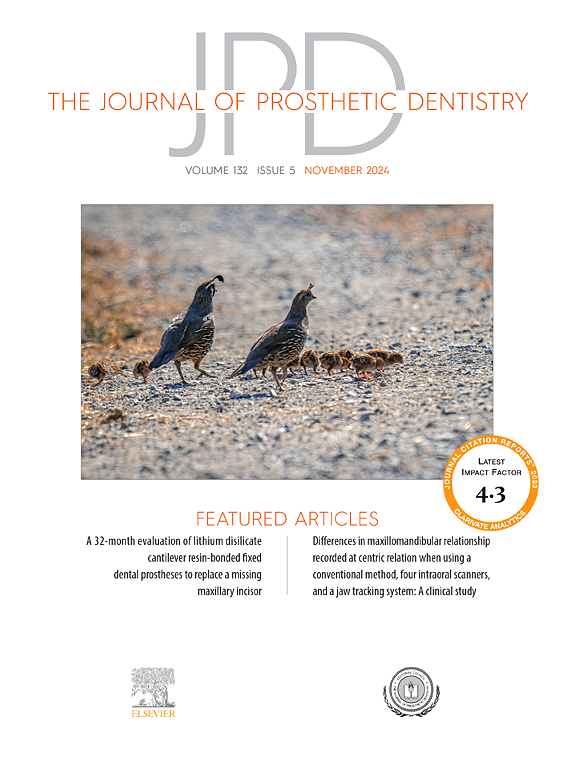不同底漆及胶粘剂体系组合对二硅酸锂树脂粘接耐久性的影响。
IF 4.8
2区 医学
Q1 DENTISTRY, ORAL SURGERY & MEDICINE
引用次数: 0
摘要
问题陈述:所有不同成分混合在单一成分中的通用牙底漆和粘合剂系统的长期性能尚未被彻底研究。目的:本体外研究的目的是评价各种硅烷复合树脂在应用该体系的专用底漆或应用纯硅烷底漆(Hoffmann’s Silan)后与二硅酸锂陶瓷的结合强度和耐久性。材料与方法:将128个二硅酸锂样品用氢氟酸蚀刻,根据指定的粘接体系随机分为4组。每组又分为2个亚组:第一组以指定体系的引物为条件,第二组以纯硅烷引物为条件。填充复合树脂(Clearfil FII New Bond)的有机玻璃管使用指定的复合树脂粘接在二硅酸锂样品上。每个亚组中一半的标本在37℃的蒸馏水中保存3天,另一半进行150天以上的人工老化和37 500个热循环(5℃至55℃)。所有幸存的试样在万能试验机上进行拉伸粘结强度(TBS)测试。采用3-way ANOVA进行统计分析,然后分别进行2-way和1-way ANOVA分析。采用Tukey HSD检验作为两两比较的事后检验(α= 0.05)。结果:所有的标本在储存和热循环中均存活,无粘结破坏。人工老化150 d后,TBS平均值为11.0±4.1 MPa ~ 50.7±7.4 MPa。胶粘剂体系对TBS有显著影响,而调理方法和人工老化对各组TBS的影响均无统计学意义。结论:除2组外,其余各组结合力均受人工老化影响。150天后,粘接剂系统对TBS的影响显著。在150天后,使用新混合的硅烷导致所有系统的结合强度都高于使用系统专用底漆或粘合剂单体,尽管对所有系统的增加并不具有统计学意义。本文章由计算机程序翻译,如有差异,请以英文原文为准。
Influence of different primers and adhesive system combinations on the durability of resin bonding to lithium disilicate
Statement of problem
The long-term performance of universal dental primers and adhesive systems where all the different components are mixed in a single composition has not yet been thoroughly investigated.
Purpose
The purpose of this in vitro study was to evaluate the bond strength and the durability of various luting composite resins to lithium disilicate ceramic after the application of the system’s specific primer or after the application of a pure silane primer (Hoffmann’s Silan).
Material and methods
A total of 128 lithium disilicate specimens were etched with hydrofluoric acid and randomly divided into 4 main groups according to the assigned adhesive system. Each group was further divided into 2 subgroups: the first was conditioned with the specified system’s primer, while the second was conditioned with a pure silane primer. Plexiglas tubes filled with composite resin (Clearfil FII New Bond) were adhesively bonded to the lithium disilicate specimens using the assigned luting composite resin. Half of the specimens in each subgroup were stored in distilled water at 37 °C for 3 days, while the other half were subjected to artificial aging over 150 days and 37 500 thermal cycles (5 °C to 55 °C). All surviving specimens underwent tensile bond strength (TBS) testing in a universal testing machine. Statistical evaluation was carried out using 3-way ANOVA, followed by separate 2-way and 1-way ANOVAs. The Tukey HSD test was applied as a post hoc test for pairwise comparisons (α=.05).
Results
All specimens survived storage and thermal cycling without failure of the adhesive bonds. After 150 days of artificial aging the mean TBS values ranged from 11.0 ±4.1 MPa to 50.7 ±7.4 MPa. The adhesive system had a significant effect on the resulting TBS, whereas the effect of the conditioning method and artificial aging was not statistically significant for all groups.
Conclusions
Artificial aging had a negative effect on the bond strength of all groups except 2. After 150 days, the adhesive system significantly influenced the resulting TBS. The use of freshly mixed silane resulted in higher bond strength for all systems after 150 days than the use of the system-specific primer or adhesive monomer, although the increase was not statistically significant for all systems.
求助全文
通过发布文献求助,成功后即可免费获取论文全文。
去求助
来源期刊

Journal of Prosthetic Dentistry
医学-牙科与口腔外科
CiteScore
7.00
自引率
13.00%
发文量
599
审稿时长
69 days
期刊介绍:
The Journal of Prosthetic Dentistry is the leading professional journal devoted exclusively to prosthetic and restorative dentistry. The Journal is the official publication for 24 leading U.S. international prosthodontic organizations. The monthly publication features timely, original peer-reviewed articles on the newest techniques, dental materials, and research findings. The Journal serves prosthodontists and dentists in advanced practice, and features color photos that illustrate many step-by-step procedures. The Journal of Prosthetic Dentistry is included in Index Medicus and CINAHL.
 求助内容:
求助内容: 应助结果提醒方式:
应助结果提醒方式:


